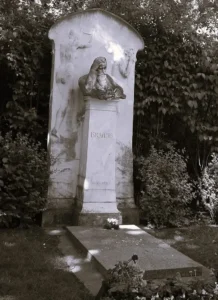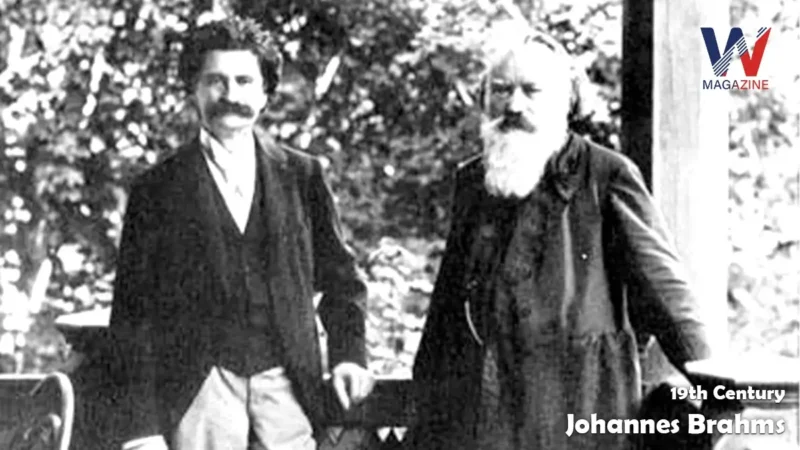Table of Contents
Introduction
Johannes Brahms was a German composer and pianist who lived during the mid-Romantic period. He was born on May 7, 1833, in Hamburg and later made Vienna his home. Brahms is often mentioned alongside Johann Sebastian Bach and Ludwig van Beethoven as one of the “Three Bs” of classical music, a trio celebrated for their influential contributions.
Brahms was known for his skill in playing the piano and composed music for orchestras, small groups, piano, organ, singers and choirs. He often performed his own music for the first time and worked with famous musicians of his era, like the pianist Clara Schumann and the violinist Joseph Joachim, who were also his good friends.
His music combines the traditional forms of earlier classical composers with the emotional depth of Romantic music. While some people of his time thought his music was too traditional/academic, others, including later composers like Arnold Schoenberg and Edward Elgar, greatly admired his work. Brahms’s attention to detail and structure in his compositions inspired many future musicians. Stay with Wordle Magazine to know more about Johannes Brahms.
Life of Johannes Brahms
Johannes Brahms was born in Hamburg, Germany, in 1833. His father, Johann Jakob Brahms, was a musician who played several instruments and worked in theaters and the local philharmonic. Despite some family objections, Johann Jakob pursued a career in music, which later influenced Johannes. Brahms showed early talent in music, learning to play piano and cello from a young age. By the age of ten, he was performing in concerts and soon he began composing his own music.
From the age of seven, Brahms received formal music lessons, starting with piano and later including cello and horn. His first piano teacher: Otto Cossel, saw potential in him but noted Brahms’s preference for composing over practicing performance pieces. Brahms continued his education with Eduard Marxsen, who taught him about the works of classical composers like Beethoven and Bach, deeply influencing his musical style.
Brahms’s big break came through his association with Ede Reményi, a Hungarian violinist, who introduced him to the Hungarian style of music that later influenced his popular Hungarian Dances. In the early 1850s, Brahms met the famous violinist Joseph Joachim, who became a lifelong friend and introduced Brahms to influential figures like Franz Liszt and Robert Schumann. Schumann was particularly impressed with Brahms, predicting a bright future for him in a famous article.
Despite his growing reputation, Brahms faced several professional setbacks, including the initially poor reception of his First Piano Concerto. However, his dedication to his craft continued to yield fruit. His compositions began to gain popularity, and he forged important professional relationships, such as with his publisher Simrock. Brahms also became engaged to Agathe von Siebold, though the engagement was broken off, marking a significant personal disappointment.
By the 1860s, Brahms had settled in Vienna, which became his home for the rest of his life. He took on roles such as the conductor of the Wiener Singakademie, where he impressed audiences with his programming choices and his own compositions. His music, including A German Requiem and various orchestral works, started to be celebrated across Europe. During this period, he also developed a deep but platonic relationship with Clara Schumann, the widow of Robert Schumann, who was a significant influence and support in his life.
Later Years and Legacy

In his later years, Brahms continued to compose important works, including symphonies and concertos that cemented his reputation as a leading composer of his time. He also supported younger musicians like Antonín Dvořák and maintained a robust schedule of performing and conducting. Despite contemplating retirement in the 1890s, he continued to create, producing significant late works like the Clarinet Quintet.
Brahms died in 1897 in Vienna. His life was marked by a blend of traditional and innovative musical thinking, contributing enduringly to classical music. His legacy is one of meticulous craftsmanship and a profound depth of emotional expression in music.
Johannes Brahms’ Famous Works
Johannes Brahms was a prolific composer whose works span a variety of musical genres and forms. His compositions are celebrated for their depth and technical mastery.
Orchestral Works
Brahms composed four symphonies, each with its own distinct character and mood. His First Symphony, often dubbed “Beethoven’s Tenth” due to its stylistic similarities to Beethoven’s work, showcases Brahms’ mastery in developing musical themes. His Second Symphony is lighter and more pastoral, while the Third Symphony is notable for its lyrical qualities and compact motifs. The Fourth Symphony is revered for its intricate use of musical forms like the passacaglia (a theme with variations) in the final movement.
His concertos are also highly regarded. The Piano Concerto No. 1 and Piano Concerto No. 2 offer a grand scale of pianistic and orchestral interplay, with the second concerto being particularly expansive and rich. The Violin Concerto and Double Concerto for Violin and Cello are staples in the concerto repertoire, celebrated for their lyrical beauty and demanding solo parts.
Choral Works
Brahms’ A German Requiem is one of his most profound works, differing from traditional requiems as it focuses more on comforting the living rather than mourning the dead. This large-scale work for chorus and orchestra is based on texts Brahms selected from the Bible, and it reflects his personal experiences of loss and reflection.
Chamber Music
Brahms was also a master of chamber music, producing string quartets, piano trios, and more during his lifetime. Highlights include his String Sextets, Piano Quintet, and the emotionally charged Clarinet Quintet. These works are renowned for their rich textures and the interplay of instrumental voices.
Piano Works

For solo piano, Brahms wrote a variety of pieces that range from sonatas to shorter character pieces. His Handel Variations and Paganini Variations are brilliant showcases of his ability to transform a simple theme into complex, intricate variations. The Hungarian Dances, composed for four hands at one piano, remain among his most popular compositions due to their lively rhythms and memorable melodies.
Lieder and Vocal Music
Brahms composed over 200 songs (Lieder), which are celebrated for their lyrical qualities and depth of emotion. These songs often explore themes of love, nature and folklore, with Brahms’ meticulous attention to the setting of text enhancing their expressive power.
Late Works
Towards the end of his life, Brahms composed the Intermezzi, short piano pieces that are introspective and contemplative. His final works, the Eleven Chorale Preludes for Organ, are considered key contributions to the organ repertoire, offering a somber and reflective look at the traditional chorale form.
Brahms Beliefs
Johannes Brahms was raised in the Lutheran faith, having been baptized and confirmed in that church during his early life in Hamburg. However, as he matured, his views shifted more towards agnosticism and humanism. Brahms’ approach to religion was more intellectual and philosophical rather than devout.

His perspective on spirituality is reflected in his music, particularly in works like “A German Requiem.” Unlike traditional requiems that focus on the Christian liturgy, Brahms chose texts from the Bible that emphasized a humanistic sympathy towards life and death, which catered to a broader audience. This approach underscored his belief in the universal experience of grief and consolation rather than specific religious doctrine.
Antonín Dvořák, a devout Catholic and a contemporary of Brahms, once expressed surprise at Brahms’ lack of religious belief, highlighting the contrast between their personal convictions despite their mutual respect as composers.
Brahms’ focus on humanist themes and his reluctance to infuse overtly religious texts into his compositions underscore his belief in the power of music to express universal human emotions and experiences, transcending specific religious or cultural boundaries.
Notable Questions Asked About Johannes Brahms
Who is Johannes Brahms Father?
Johannes Brahms’ father was Johann Jakob Brahms. He was originally from the town of Heide in Holstein. Johann Jakob was a musician who played several instruments and worked primarily as a jobbing musician and a string and wind player when he moved to Hamburg. He eventually became a double-bass player in the Stadttheater Hamburg and the Hamburg Philharmonic Society. His musical career significantly influenced his son, Johannes Brahms, who became one of the major composers of the 19th century.
When did Johannes Brahms died?
Johannes Brahms died on April 3, 1897. He passed away in Vienna, Austria, where he had spent much of his professional life.
Who is Johannes Brahms Wife?
Johannes Brahms never married. He had several close relationships and friendships throughout his life, notably with Clara Schumann, the wife of composer Robert Schumann. Although their relationship was deep and affectionate, it remained platonic. Brahms had a complicated personal life and was known for his solitary nature, which might have influenced his decision not to marry.
Follow Wordle Magazine to learn more about renowned personalities.









